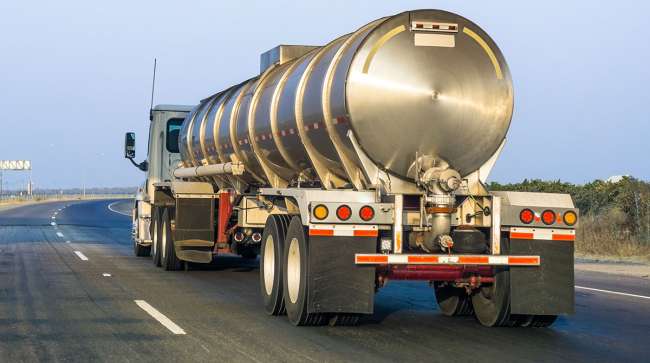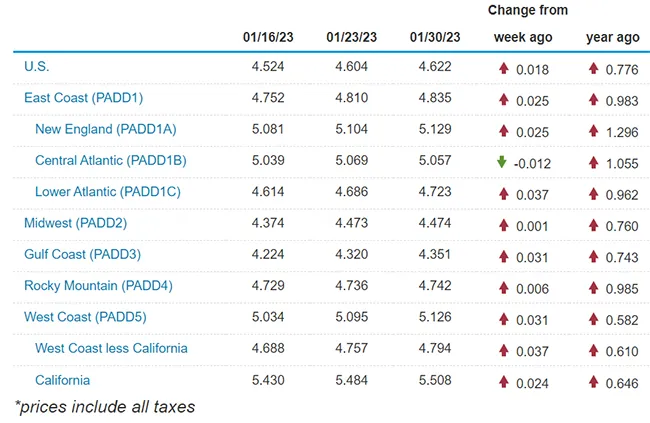Senior Reporter
Diesel Up 1.8¢ to $4.622 in Third Increase of 2023

[Stay on top of transportation news: Get TTNews in your inbox.]
The national average price of diesel nudged up 1.8 cents to $4.622 a gallon, according to Energy Information Administration data released Jan. 30.
The week marks just the third increase in the past 12 weeks, but all three have come in the new year.
Trucking’s main fuel now costs 77.6 cents more than it did at this time in 2022.
Of the 10 regions in EIA’s weekly survey, the average price for a gallon of diesel went up in nine — the exception being a 1.2-cent dip in the Central Atlantic. The biggest gain, 3.7 cents, was found in the West Coast less California and the Lower Atlantic.
U.S. average on-highway #diesel fuel price on January 30, 2023 was $4.622/gal, UP 1.8¢/gallon from 1/23/23, UP 77.6¢/gallon from year ago #truckers #shippers #fuelprices https://t.co/lPvRNZFztg pic.twitter.com/U4sxuA2jqE — EIA (@EIAgov) January 31, 2023
Meanwhile, gasoline jumped up by 7.4 cents on the national average and is holding at $3.489 a gallon.
With oil prices hovering around $80 a barrel, U.S. drivers won’t see a dip in prices within the next couple of weeks, and analysts who spoke with Transport Topics say other, underlying factors are inching prices upward.
One is the shortage of excess refining capacity and after several months of running at nearly full capacity, in some cases at 95%, EIA says in the last several weeks refineries are running at a much lower rate, producing less gasoline and diesel.
U.S. refining capacity has dipped substantially from a three-year high of 95.5% the week ending Dec. 9, to 92.2% the following week and then 79.9% the week between Christmas and the New Year holiday to now back up to 86.6%.
The big drop in December is being blamed on a cold snap that hit several states in the Deep South, including heavy oil producers Texas and Louisiana.

Flynn
But now, according to oil industry analyst Phil Flynn with Price Futures Group in Chicago, many of those refineries are being taken down for maintenance and to prepare for the spring months, when gasoline is blended differently to prevent ozone pollution. In some cases, that process will take several weeks.
“The short term has been the weather. But you’ve got a situation where demand is better than anticipated and the Department of Energy demand forecasts are going up, after under-reporting energy demand by 400,000 barrels a day. That’s a lot of under-reporting and they’ve done that two months in a row,” Flynn said. “Refinery maintenance is playing into it and because of the war in Ukraine the refineries were running at full capacity and some of that is slowing down, and the global demand continues to be pretty good.”
While prices are up in the short term, EIA’s January 2023 Short Term Energy Outlook paints a slightly optimistic outlook for oil, gasoline and diesel prices in 2023 and 2024.
EIA projects U.S. oil prices will average $83.10 a barrel this year and fall to $77.57 in 2024. Retail gasoline is forecast to average $3.32 in 2023 and decline to $3.09 in 2024.
The EIA report says diesel prices will average about $4.20 a gallon in 2023, down 16% from 2022, and continue to decline in 2024 to near $3.70 a gallon.
The lower prices for energy will take place as domestic oil production returns to pre-pandemic, 2019 levels in the next two years. EIA says that number will climb by 550,000 barrels a day from 2022’s 11.86 million barrels per day to 12.41 million in 2023 and rising another 400,000 barrels per day to 12.81 million in 2024.
U.S. average price for regular-grade #gasoline on January 30, 2023 was $3.489/gal, UP 7.4¢/gallon from 1/23/23, UP 12.1 ¢/gallon from year ago #gasprices https://t.co/jZphFa0hDF pic.twitter.com/zGjCjeYsZS — EIA (@EIAgov) January 31, 2023
Another factor in the anticipated lower prices for petroleum products is declining demand, possibly caused by a U.S. recession in 2023.
EIA says it is making these forecasts anticipating slower economic growth in 2023 of .5% overall and increasing to 1.9% in 2024.
However, oil industry analyst Tom Kloza, founder of the Oil Price Information Service, told Transport Topics that consumers are likely to see higher gasoline and diesel prices in the spring, with gasoline possibly nearing $4 a gallon nationally, but he does not anticipate that price increase holding.

Kloza
“I think you’re going to see a mixed bag; ultimately we’ll go higher, but ultimately means March or April,” Kloza said. “People aren’t really driving that much. Demand for gasoline is about 8 million barrels per day and remember it averaged 9.3 million barrels per day from 2016 to 2019. I think we’re going to see a pause here for gasoline increases. But later this year I think we could see an average price for gasoline between $3.75 and $3.99. I’m hesitant to say $4 a gallon.”
Kloza says the exceptionally warm January along the East Coast, one of the warmest in more than half a century, according to the National Weather Service, is driving down demand for home heating oil, which from a molecular standpoint is nearly identical to diesel, used in trucks.
“They keep breaking these records for the warmest months ever,” he said. “Diesel was basically pricing in a very cold winter and this hasn’t happened.”
U.S. On-Highway Diesel Fuel Prices

EIA.gov
Want more news? Listen to today's daily briefing below or go here for more info:


